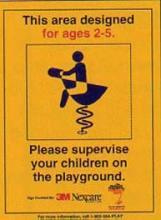
Signs and Labels on and around playground equipment provide safety information on playgrounds. Some signs are for information, some are for warning, and some are for user education.1
The signs and labels typically associated with playgrounds are as follows:
Information signs:2
- Manufacturer’s Identification (Required)
- Age appropriateness (Required)
- Supervision recommendation (Required)
- Ideal surfacing depth markers3 (Recommended)
Warning signs:4
- Removal of helmets, drawstrings, or accessories around the neck (Required)
- Hot play surfaces (Required)
- Hard Surfaces (Required)
User education:5
- Rules (Recommended)
- General Information (Recommended)
- Street Signs (Recommended)
Having signs with the appropriate age of users is especially important as it will help caregivers to direct children to equipment appropriate for their age. The use of play equipment inappropriate for a child’s age has been identified as one of the leading causes of playground accidents. These signs may also assist owners in case of litigation resulting from inappropriate use of equipment due to age on playgrounds that are clearly signed for age appropriate use.
Rules signs and general information signs are recommended for public parks as the playgrounds in these facilities are generally not supervised. Signs can provide useful information to playground users such as rules and information about the times the facility is open for use, whether pets are allowed, who to contact for concerns about the facility or a number to call in an emergency, or other information specific to the facility. Signs should be brief and to the point. Multi-language signs can also be effective in areas where more than one language is predominant.
In playground facilities where use and access is restricted to members or constituents and used only under supervision, the general information and rules signs are less important. Examples of this type of facility are child care centers or private clubs.
Signs should be placed at the entrance to the play area or in a conspicuous location on the equipment. Freestanding signs must be near the play equipment entrance but outside of the use zone.6
Labels must be durable. It is the owner/operator’s responsibility to replace the labels if they should be vandalized or become illegible.7
Street signs are generally used on streets near public playgrounds and schools. The purpose of these signs is to warn motorists of playgrounds in the vicinity and to slow down. The wording on these signs is commonly “Slow Children at Play.”8 Some areas use a sign with a see-saw and no wording to represent a playground. The use of street signs is regulated by the local municipality.
- 1. Kutska, Kenneth. Playground Safety is No Accident, Fifth Edition. International Playground Safety Institute, 2011, pp. 175-178.
- 2. ASTM International (ASTM) Standard F 1487-11, “Standard Consumer Safety Performance Specification for Playground Equipment for Public Use,” Sections 14 and 15, pp. 18-19.
- 3. Consumer Product Safety Commission (CPSC) publication #325, “Public Playground Safety Handbook,” Section 4.3, pp. 18-19.
- 4. Op. cit. ASTM F 1487-11, Section 14, pp. 18-19.
- 5. Op. cit., Kutska.
- 6. Op. cit., ASTM F 1487-11, Section 15, pp. 18-19.
- 7. Op. cit,. ASTM F 1487-11, Section 14, p. 19.
- 8. “Slow Children at Play.”Wikipedia, < http://en.wikipedia.org/wiki/Slow_Children_At_Play > 22 Jan. 2014.

